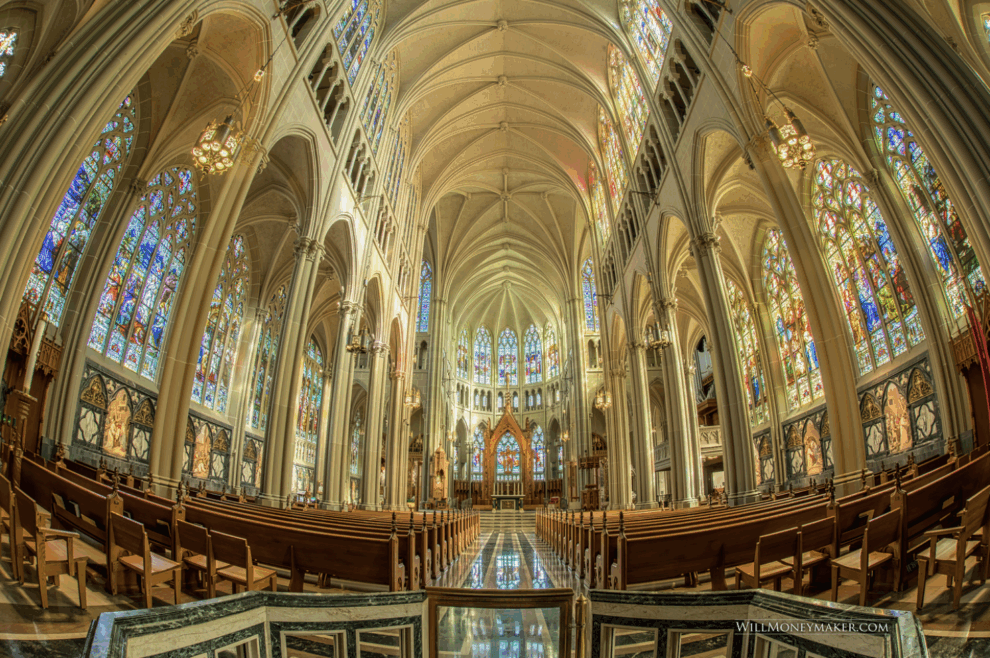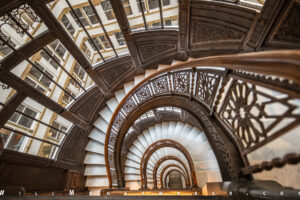Architectural photography is a problematic genre with little details that need attention. In my opinion, this kind of imagery relies heavily on geometry, more so than many other genres. Because of this, and because of the limitations of cameras and lenses, it can be tough to bring an architectural image together to become a piece of art. Because this is a genre that everyone struggles with, let me show you some of my favorite tips and tricks!
Composition Must Be Stellar
In architectural photography, the composition must be on point. With all of the geometry and the straight lines, there is nowhere for compositional flaws to hide. This doesn’t necessarily mean that you must always abide by the Rule of Thirds. In fact, in many architectural photos, you’ll find elements like a staircase or doorway centered.
What it does mean is that you will need to place elements carefully. Think of all the lines in each image before you take the image — the line where the floor meets the walls, where the ceiling meets the walls, where the walls meet each other, and so on. Whether you are using the Rule of Thirds or composing by another method, make sure that each prominent element like this fits into the photo in an organized, deliberate way. Where possible, make certain floor, and ceiling lines are perfectly horizontal and lines where walls meet are perfectly vertical.

Making Use of Leading Lines
Lines are a common theme in architectural photography — an almost inescapable theme. Leading lines, or lines that draw a viewer’s eye into an image, are ubiquitous.
The first thing you will want to do when using leading lines is locate them. Indoors, it might be something like the curve of a stairwell leading up to a balcony or rows of benches with a path in between that leads the viewer’s eye to the image's background. Outside, leading lines may look similar, like a road or sidewalk leading to the building you are photographing.
Whatever the leading lines are, your job is to make sure they have a purpose. If you notice a line that draws your attention from one part of a photograph to another, then make sure that wherever the line draws you to is interesting. Think of it in terms of going on a journey. Whatever is at the end of your route is hopefully worth the trip you took to get there. Leading lines should be utilized in the same way. If you include them, make sure that they lead the viewer on a worthwhile journey.
Other Ways to Use Lines
Lines don’t necessarily need to lead viewers through the image. They can be used in various ways, so always be on the lookout for interesting effects that you can accomplish.
As an example, one of my favorite ways to use lines is as a frame. Imagine if you are standing in a cathedral, looking down a long row of pews into a basilica. The pillars arching up into the ceiling provide the perfect frame for the pulpit. Doorways and windows can also be used in this way.
On the outside, look for framing elements like rooflines. Even though they may not frame the entire building, they will still give the building that “framed in” feeling. Roads are another way to accomplish this from the outside. If you happen to be standing at an intersection, you may be able to use those two converging roads to frame the building in from the bottom.

Shoot Wide
Indoors or outdoors, it is wise to take wide-angle photos whenever you can, even if it means you must crop images later on. There are two good reasons for this. First, wide-angle images let you capture more of the details around the edges. This is particularly helpful when you don’t have a great vantage to shoot from. If you can’t back farther away from the room or building you are photographing, then the wide-angle lens will help you make up for that by giving you a more expansive view.
Secondly, architectural photography, particularly indoor photography, has a natural tendency to feel cramped, almost like the walls are closing in. It almost makes you uncomfortable to look at the finished image in extreme cases. Wide-angle lenses help to combat this claustrophobic feeling by altering the perspective somewhat. When you take a wide-angle shot, the foreground objects will seem a little larger or nearer to the camera, making the room feel more open.

Architectural Photography Outdoors
The things I have talked about apply to outdoor architectural photography as much as they do to indoor photography. However, outdoor photography adds one additional challenge: the weather. If you are able, it helps to plan around the weather and around sunrise and sunset to get the perfect exposure. By and large, the most common issue is an overexposed sky or underexposed foreground, so by choosing days to photograph according to the weather and the position of the sun in the sky, you can help minimize exposure balance issues.
Sometimes, there is no help for it — the sky is too bright no matter how well you’ve planned. In these instances, there are a few options you can try. If you have one, a neutral density filter may help balance the exposure. Alternatively, you could create an HDR (high dynamic range) image by exposing one frame for the building and another for the sky so that you can combine the two later in photo editing software. Or, you could use a sky from another photo in your collection as an overlay.
Architectural photography is challenging, but the challenges are undoubtedly worthwhile. It is a unique genre in that few other types of photography allow you so much freedom to explore exciting geometry. Practice, and before too long, I am sure you will see the beauty in your architectural photographs!



